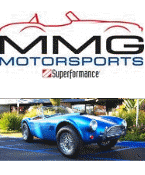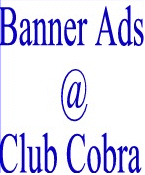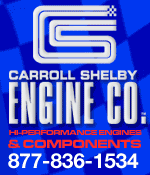 
 Main Menu
Main Menu
|
 Nevada Classics
Nevada Classics
|
 Advertise at CC
Advertise at CC
|
 November 2025
November 2025
|
| S |
M |
T |
W |
T |
F |
S |
| |
|
|
|
|
|
1 |
| 2 |
3 |
4 |
5 |
6 |
7 |
8 |
| 9 |
10 |
11 |
12 |
13 |
14 |
15 |
| 16 |
17 |
18 |
19 |
20 |
21 |
22 |
| 23 |
24 |
25 |
26 |
27 |
28 |
29 |
| 30 |
|
|
|
|
|
|
|
 CC Advertisers
CC Advertisers
|
|

06-03-2005, 06:33 PM
|
|
CC Member

|
|
|
Join Date: Jun 2004
Cobra Make, Engine:
Posts: 14
|
|

 Not Ranked
Not Ranked
 Inverted Vee Conversion
Inverted Vee Conversion
Let's say I want to run an inverted 460, and I'm toying with the idea of using Arao heads and "reverse-engineering" BMW's direct injection technology -- possibly with port-type injection in addition (depends on how much power the reverse-engineered components will support). Alternatively, assume the use of either wedge or hemi heads and port-type injection.
Obviously, in such a case, the valve covers become the oil pan(s), so I'm thinking "dry sumped" valve covers are in order. Would I be able to use normal pistons and rings? Would I need to scavenge the crankcase?
Imagine the whole assembly rotated alternately -- in 15-degree increments through 90 degrees -- about the crankshaft's longitudinal axis (6 separate and distinct orintations in either direction, in addition to the original inverted position). Imagine the crankshaft in the traditional orientation coaxial with the longitudinal axis of the vehicle, and imagine the crankshaft's longitudinal alternately perpendicular to the longitudinal axis of the vehicle. How do these various orientations effect oiling and oil control? Assume vehicular longitudinal-axis acceleration forces of +1.5/-2.5g and vehicular lateral-axis acceleration forces of +/- 1.5g.
Is the aforementioned method adequate to prevent the pooling of oil in the combustion chamber?
What else needs to be done to ensure "upright engine" reliability, longevity, power, etc.?

|
-
Advertising


06-03-2005, 06:58 PM
|
|
CC Member

|
|
|
Join Date: Dec 2001
Location: Louisville,
KY
Cobra Make, Engine: I'm Cobra-less!
Posts: 9,417
|
|

 Not Ranked
Not Ranked
Why?
|

06-03-2005, 07:53 PM
|
|
CC Member

|
|
|
Join Date: Oct 2003
Posts: 4,078
|
|

 Not Ranked
Not Ranked
You'd have a very unusual hood shape to conceal those gyrations.
Oh, and distinctive body cutouts for the flapping sidepipes.
Call George Barris.
As bly asked,
"Why"?
__________________
Chas.
|

06-04-2005, 01:06 AM
|
|
CC Member

|
|
|
Join Date: Jun 2004
Cobra Make, Engine:
Posts: 14
|
|

 Not Ranked
Not Ranked

Low CG -- and I'm thinking that ... with a little effort ... a gearbox could be situated in the valley, making the drivetrain amazingly compact.
Of course, someone will probably take that idea and do it in a commercially expedient but nevertheless improper or inefficient way -- and if they're first to market, doing it the right way becomes cost-prohibitive.
The Germans used inverted-vee aircraft engines in WWII. Some were wildly successful; others weren't -- but I'm not convinced their reliability problems had so much to do with the underlying technology as industrial sabotage. Carbureted homebuilt aircraft have been built with "upside-down" V8 passenger car engines; the last one I saw used an inverted Oldsmobile mill. The problem is not just in finding good technical/development information about these types of powerplants; in most cases, there doesn't readily appear to be ANY such information about them.
I'm thinking if the technology can be made to work well in an engine like the 460 (or a 302W, for that matter), it would be fairly easy to transfer it to the new modular Ford engines.
I can't get into exhaust routing right now, but think how much sense it makes for the intake to be mounted above the exhaust: that's backwards from the normal, natural flow of heated air.

|

06-05-2005, 11:14 AM
|
|
CC Member

|
|
|
Join Date: Jun 2004
Cobra Make, Engine:
Posts: 14
|
|

 Not Ranked
Not Ranked
 Continued thinking ...
Continued thinking ...
In an aircraft, the inverted vee allows spark plug access from beneath the plane, which is a lot more convenient than having to use an access stand to reach the plugs from the top. However, it wouldn't be necessary to access the plugs from underneath the car: if the engine/transmission combination was properly suspended, it could be flipped while still in the car -- so that the drivetrain and the plugs were easily accessible by technicians.
Such a drivetrain configuration would be of greatest benefit both to users of trucks and vans, and to users of vehicles having a mid-engine platform (F1 competition vehicles, etc.). The cavernous and lengthy space between the banks would permit the use of extraordinarily wide gears and other "ridiculously robust" transmission components.
"Traditional" methodology would place a transfer case at one end of the cylinder block (chain transfer of power -- sort of like with a timing chain setup -- would be more efficient than the use of gears, but someone would probably make a gear drive), and a "third member" at the opposite end of the block; however, transverse engine orientations would benefit from the ability to utilize common-component equal-length halfshafts (differential output torque pickup points located equidistant from the driven wheels).
In some applications, the drivetrain package could incorporate suspension pickup points; in other applications, mounting could be via cradle.

|

06-07-2005, 11:36 AM
|
 |
CC Member

|
|
|
Join Date: Mar 2005
Location: Crowley,
LA
Cobra Make, Engine: Findling 001 - starting scratch build
Posts: 206
|
|

 Not Ranked
Not Ranked
 Inverted Vee
Inverted Vee
Another reason for the inverted arrangement used on the DB600 series
engines was gun placement. Designers
of the day felt that having a large caliber
cannon on the airframe's centreline was
advantageous compared to wing-mounted
armament. On aircraft like the Bf109, a
20 mm cannon was mounted inside the
vee of the DB engine. Since the propeller
was attached to a spur-gear reduction
hub, the propeller hub cenreline was
lowered to a point within the vee. The
output shaft of the reduction box on which
the prop itself was mounted was hollow
and open at both ends of the gearbox.
That way, it was a simple matter to mount
the gun within the vee and have the
muzzle of it looking through the hollow
output shaft. While a similar arrangement
could have been done with an upright vee,
the inverted arrangement made for better packaging and service accessibility.
.....Fred
|

06-07-2005, 03:31 PM
|
 |
CC Member

|
|
|
Join Date: Apr 2005
Location: Bullhead City,
AZ
Cobra Make, Engine: CSX4815
Posts: 130
|
|

 Not Ranked
Not Ranked

One thing that has not been mentioned is that the inverted V also gives greater propeller clearence...something that you don't have to worry about! Leave the engine right side up and save yourself a multitude of problems! These engines were not designed to be turned upside down. You would be risking hydrolic lock from oil seeping in to the combustion chamber past the rings when it is at rest for an extended time. Just like having to pull a radial engine through by hand before you start it when it is cold, I would think you would need to "pull the engine through" a couple of cycles to make sure that oil has not collected in the cylinders, like you would an airplane, before you hit the starter! I have seen radials that have "locked up" in in less than two turns because of oil in the lower cylinders! It gets REAL EXPENSIVE REAL FAST! I know, as I have flown many old airplanes and currently fly a 1937 Howard DGA-11 with a Pratt & Whitmey R-985.
And yes, you would have to scavange the oil from the crankcase just like an aircraft engine! Just my $02!
Good luck!
Mike

|

06-07-2005, 05:29 PM
|
 |
CC Member

|
|
|
Join Date: Jan 2003
Location: Atlanta,
GA
Cobra Make, Engine: CAV GT40 with 331 KC
Posts: 2,187
|
|

 Not Ranked
Not Ranked
It simply amazes me that someone hasn't tried this already!
|

06-08-2005, 05:39 AM
|
|
CC Member

|
|
|
Join Date: Jul 2004
Location: D'Lo,
ms
Cobra Make, Engine: made mine from molds taken off an original, 302/ 351 heads hand made intake drysump oil system, and lots of nitrous.
Posts: 37
|
|

 Not Ranked
Not Ranked
 maybe im dumb.
maybe im dumb.
well, maybe I'm dumb, but aren't our piston bottoms shaped like bowls (pretty much)? and wouldn'n oil build up in the piston bottoms over time? and if this took place wouldnt it throw the driveline out of balance like a drunken monkey? If thats already been stated i appologise, as ive only had about 3 minutes to read and reply at work.
__________________
Aoccdrnig to a rscheearch at Cmabrigde Uinervtisy, it deosn't mttaer inwaht oredr the ltteers in a wrod are, the olny iprmoetnt tihng is taht the frist and lsat ltteer be at the rghit pclae. The rset can be a total mses and you can sitll raed it wouthit a porbelm. Tihs is bcuseae the huamn mnid deos not raed ervey lteter by istlef, but the wrod as a wlohe. Amzanig huh?
|

06-15-2005, 04:22 PM
|
|
Club Cobra Member

|
|
|
Join Date: Feb 2003
Location: SF East Bay,
Ca
Cobra Make, Engine: SPF
Posts: 499
|
|

 Not Ranked
Not Ranked
Ummm, I cannot imagine any of the advantages you have mentioned so far as being enough to justify the engineering effort involved. If you are worried about sparkplug access then build a small block car. You can almost stand in the compartment. As for lowering the CG, go with alum heads. Hydraulic lock would be a very real problem. I never start a round aircraft engine without running the engine through a complete cycle either by hand or on the starter only (depends on the type of aircraft and engine) before adding fuel or spark. You can cause some very expensive damage in a big hurry if you just start one up and it is locked. For sure inverting it would be cool, but it just seems like there are easier ways to overcome the problems you have posted.
__________________
We have enough youth. What we need is a fountain of common sense
|

06-16-2005, 09:41 AM
|
|
CC Member

|
|
|
Join Date: May 2002
Location: San Francisco CA,
Posts: 525
|
|

 Not Ranked
Not Ranked
 German inverted V's
German inverted V's
The famous Damlier Benz DB 601/605 and Junkers Jumo 211/213
inverted V engines were marvels of engineering.
As Fred stated, the advantage of having a 20mm cannon firing (MG FF, MG 151 and the later 30mm MK 108 used in the Me 109 K series) through the prop was important but the inverted engines were introduced long before the centerline cannon was used.
The main reason for the inverted engine was the lowering of the thrust line in relation to the airframe. The lower center of gravity, which is closer to the central plane of the wing made for superoir flight characteristics. As far as armament placement was concerned, the inverted V configuration was more important for the cowl mounted machine guns, which every fighter aircraft built by the Luftwaffe had. The inverted V allowed more room in the upper cowl area, alowing two 7.9mm and later 13mm machine guns to be mounted tightly against the sides of the engine.
As far as prop clearance is concerned the only German inverted V that to advantage of this would be the Argus V-8 and V-12 used in aircraft like the Messerschmitt Me 108 and the Focke Wulf Fw 58 and Fw 189. The props were driven at crank speed and had no reduction crankcase. The Me 109 series and later Fw190D had a crankcase reduction gear that LOWERED the prop closer to the ground. Check the landing gear length on a Spitfire compared to a Me 109. The 109 gear legs are at least 50% longer due to the lower prop.
As for the automotive uses of an inverted V, I would say none,
especially in front engine configuration. Even with engine set-back, where are you going to put the suspension and steering components? in a front engined car, wouldn't placing the trans (specifically, trans weight)i n the center of the V destroy the weight balance?Where do you install the clutch? An inverted V engine has 5 piston rings, 2 below the piston pin and 3 above the pin in order to seal the cylinder. More piston weight. Not a problem on a 2600ci engine that only revs 2500 rpm. The questions are endless. I think if it were a viable alternative, someone, like F1, would have already tried it. In my mind having the crankshaft centerline up near the windshield is not such a good idea.
JMHO,
--Mike
__________________
They bend 'em, we mend 'em.
|
 Posting Rules
Posting Rules
|
You may not post new threads
You may not post replies
You may not post attachments
You may not edit your posts
HTML code is On
|
|
|
All times are GMT -7. The time now is 02:03 PM.
|



















 Linear Mode
Linear Mode



